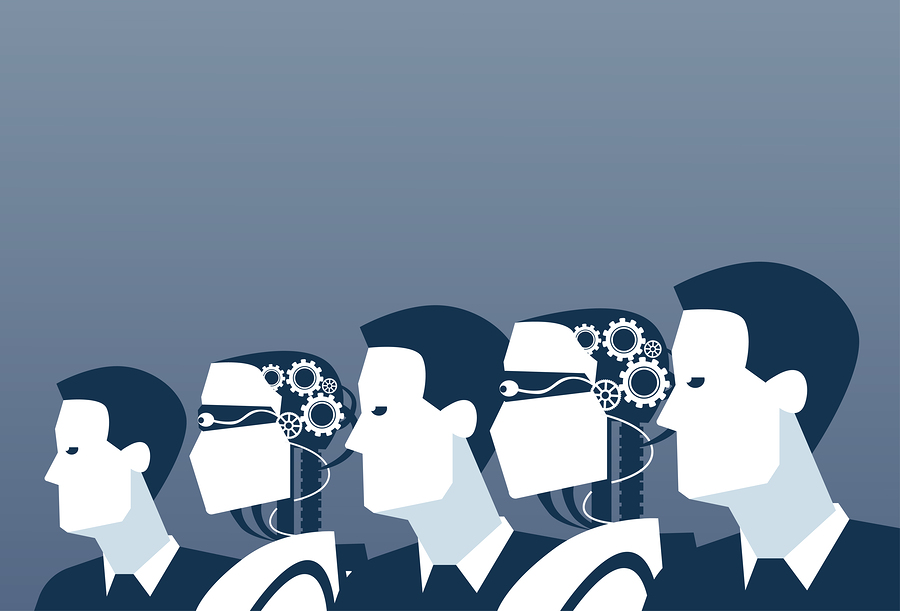Why humans and machines work better together
Humans and machines have divergent skill sets that, when combined, can transform the way we work

It wasn’t that long ago that robots and artificial intelligence (AI) were considered a major threat to our workforce. The press was awash with reports that they would take over our jobs and lead to widespread unemployment.
Tesla CEO Elon Musk famously warned that AI is a fundamental risk to the existence of human civilisation. “I keep sounding the alarm bell, but until people see robots going down the street killing people, they don't know how to react, because it seems so ethereal,” he told attendees at the National Governors Association summer meeting in 2017.
In just a few short years, opinions have changed considerably. Research conducted by Automation Anywhere in 2019 revealed that our global workforce is eager to adopt AI and automation. In fact, 72% of workers believe that AI and automation will help them do their jobs better, not replace them. This is opposed to just 8% of respondents who strongly feel the opposite.
“AI’s greater potential lies in leveraging the technology to enhance collaboration with humans,” says James Wilson, managing director of information technology and business research at Accenture Research, and co-author of Human + Machine: Reimagining Work in the Age of Artificial Intelligence. “This dynamic combines human talent and oversight with the nearly limitless capacity of intelligent machines to explore new possibilities.”
In other words, humans and machines have divergent skill sets. “People perform better in complex, unpredictable environments, which is why we’re better at work that involves social interaction, creativity and navigating the physical world,” explains Jeff Grisenthwaite, vice president of product at automation software provider Catalytic.
Machines, meanwhile, outperform people when faced with narrowly defined challenges that can be solved through precise repetition or rapid computation. “Robots are good at repetitive tasks – they don’t get bored – and they deliver speed and accuracy,” says Waseem Malik, executive managing director for claims at AXA Insurance.
Towards a new way of work
This collaborative approach has the potential for new, previously unimagined benefits. Rather than merely streamlining how businesses currently do work, it allows AI systems to serve as an agent for change across organisations, transforming what businesses do and how they do it. “Those companies that successfully facilitate this collaboration will be able to reimagine their organisations from the ground up,” says Wilson. “Human-AI collaboration has the potential to transform the way businesses are structured, the way they design products and even how they hire and train employees.”
Sign up today and you will receive a free copy of our Future Focus 2025 report - the leading guidance on AI, cybersecurity and other IT challenges as per 700+ senior executives
Early adopters in multiple industries are already leading the way. In retail, for example, online grocery solutions provider Ocado Technology uses robots to process over 80,000 orders every week. A proprietary 4G network acts as ‘air traffic control’ for more than 1,500 bots as they move around the warehouse. “Bringing together the best of human and machine ability is a key component to our technical success, offering a combination that far exceeds the sum of its parts,” Dr Graham Deacon, robotics research fellow at Ocado Technology, tells IT Pro.
Ocado Technology is experimenting with a number of systems which combine the best of human and machine intelligence. This includes an augmented reality system for warehouse engineers that overlays information with the physical world and helps them teleoperate complex robotic devices to fix systems in a different part of the world. “This has major benefits in terms of allowing new levels of collaboration,” says Deacon. “One single technician will be able to fix multiple systems not just remotely, but simultaneously, massively amplifying the impact of a single person.”
In financial services, meanwhile, global insurance firm AXA uses various named robots to help out in different teams. Harry keeps customer records up to date for household claims. Lenny, Como and Bert do the same for liability claims, commercial motor and commercial property; they attach incoming and outgoing messages to customer files. In the commercial lines intermediary, Clive transfers data between complex systems and spreadsheets. Meanwhile at AXA PPP Healthcare, Poppy texts customers their authorisation code for treatment while they’re on the phone with their human personal advisor. Poppy also helps with customer referrals by taking on much of the copying and pasting involved.
Malik believes that AXA’s success is a result of their understanding that there’s a time and a place for robot assistance. “In insurance, you also need the human touch,” he says. “Customers get in touch with us when they have a claim; they need to be reassured and understood. When you’re stranded abroad, or when your car needs to be fixed, you want a person to look after you, not a computer. However, you also want that person to be as efficient as possible – and that’s where machines make the difference.”
Collaborative intelligence is facilitating more effective fraud prevention too. Australian firm TrafficGuard, for example, uses machine learning to complement the skills of its analysts and data scientists. “We are capitalising on human expertise by augmenting it with machines to create a solution that neither could achieve on its own,” says Luke Taylor, the firm’s founder and chief operating officer. “Collaborative intelligence is achieved by understanding the values of both machines and people. Using machine learning, we can validate advertising engagements in milliseconds and detection can be based on immense volumes of data.”
RELATED RESOURCE

The IT Pro Podcast: Can AI ever be ethical?
As AI grows in sophistication, how can we make sure it’s being developed responsibly?
The manufacturing industry is also benefiting from the combined power of humans and machines. “Agriculture is just one example,” says Nick Grove, founder of social economy platform Peazzy. “In the slow drive towards Industry 4.0, benefits will be made with seed to sale solutions impacting incubation, growing (watering and nutrients), harvesting, production, packaging and shipping direct to end customer. This is providing access to food for certain countries that was previously impossible to achieve.”
And this is just the start. “When machines and humans collaborate together they can succeed in areas like medicine, by helping with patient diagnosis through image recognition; accounts payable, by processing thousands of invoices in a shorter amount of time and reducing potential errors on transcriptions; and legal, by reviewing thousands of contracts for specific clauses that may not comply with company policies,” adds Agustin Huerta, vice president of technology for the AI studio at digital transformation enabler Globant.
Be aware of the pitfalls
But it’s not all plain sailing. Experts are quick to warn that human-machine collaboration will present a number of risks.
Security makes the top of the list. “Connecting an increasing number of technologies opens up the possibility of a global distributed denial-of-service attack. If this were to happen at say the same time as the Coronavirus lockdown, then the world would be held to ransom within minutes. With the advancement of technology and machines comes huge responsibility,” says Grove.
Employers also need to ensure they prepare their workforce appropriately. By bringing in machines, employees might have new responsibilities within an existing role, or an entirely new job function. Those in existing non-technical roles will need to upskill to take on those that require critical thinking and learn to harness AI-assisted technologies for increased efficiency and quality. Meanwhile, workers performing routine tasks will need to cross-skill and prepare for roles that depend on uniquely human traits. “As these changes are implemented, it is important that leaders work with their HR teams to ensure that workers feel empowered, rather than threatened, by future AI developments,” says Wilson.
This is a challenge that AXA has already had to address. “At the beginning, some employees were worried that automation might destroy their jobs,” says Malik. “However, we’ve always said it is not about replacing people, but about freeing up their time so they can do what they’re good at and add real value. That can be about customer service, broker relations or anything that requires good old human intuition. The way we overcame initial worries was to engage with the teams and listen to their ideas.”
Success here depends on fostering the right culture. “A good understanding of employees’ needs and how to create a culture that embraces this new way of collaboration is what makes these programmes successful,” says Huerta. “We have seen tides change when we have been allowed to create a proper culture that fosters this kind of collaboration and works on reducing uncertainty and fear of the unknown.”
James Manderson, general manager for EMEA at customer engagement firm Braze likens this to when commercial flights first started. “A pilot’s job was very manual from take-off to landing. Today, the process of flying is mostly automated so that pilots can focus on making sure the flight is optimised and safe. The parallel with AI and machine learning is clear – innovation always pushes humans to adapt and improve. The benefits should be explained to employees in this way.”
It’s not just employees who need to be educated, it’s the whole population – and this is where the media has a crucial role to play. While in the west we often see scare stories about automation, it’s very different in Asia. “The narrative in countries such as Japan is much more positive, and often highlights the benefits of the integration of robots,” says Héctor González-Jiménez, professor at ESCP Business School. “The media should offer a more balanced narrative, which would then help firms manage this shift.”
Building a better future
Breakthroughs in areas like natural language interfaces and task understanding will also lead to a better acceptance of collaborative robots and will enable them to be used in a more natural way.
“This is an important building block that will contribute to the emergence of true collaboration between humans and cobots,” says Ocado Technology’s Deacon.
To this end, Ocado Technology is working as a project coordinator as part of the EU Horizon 2020 SecondHands Consortium to pioneer the development of a collaborative robot which can proactively offer useful support and assistance to humans in maintenance tasks. This ‘cobot’ is trained in task-understanding, to predict when and how it can usefully provide help. Safety and efficiency are clearly key drivers here. “Eventually these collaborative robots will be key for solving many societal challenges - both as assistive robots in industry, and out in the wider world such as robots for healthcare and assisted living in the home,” Deacon says.
Advances in conversational AI - the capability to truly understand what someone has said and what that means – will also expedite advances in human-machine collaboration. “Conversational AI is only now becoming really achievable, and a key part of collaborative intelligence,” says Al Cook, vice president and general manager of artificial intelligence at cloud communications firm Twilio. “Chatbots are just the tip of the iceberg of what this technology can do. It’s a good starting point for most companies, but there’s a lot more to come.”
Ultimately, Grisenthwaite believes that firms that fail to adopt these new technologies are risking their very survival. “Companies that do not fully embrace these technologies and push aggressively toward wide-scale adoption will inevitably lose to competitors,” he says. “The productivity gains of collaborative intelligence are exponential, rather than incremental, which puts early adopters at an insurmountable advantage.
-
 Trump's AI executive order could leave US in a 'regulatory vacuum'
Trump's AI executive order could leave US in a 'regulatory vacuum'News Citing a "patchwork of 50 different regulatory regimes" and "ideological bias", President Trump wants rules to be set at a federal level
-
 TPUs: Google's home advantage
TPUs: Google's home advantageITPro Podcast How does TPU v7 stack up against Nvidia's latest chips – and can Google scale AI using only its own supply?